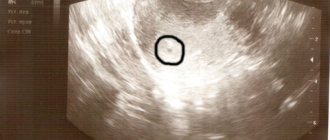During pregnancy, a woman experiences a special state of her body. And the joy of upcoming motherhood should not be overshadowed by problems with the cardiovascular system. What should you do if you are carrying a baby and have been diagnosed with sinus tachycardia? Let's look at this diagnosis.
Pregnancy is not only a pleasant period in a girl’s life. This is also a responsible time when the expectant mother should pay special attention to her health. Due to the increased load on the body, women may develop various disorders of the cardiovascular system.
Attacks of tachycardia during pregnancy are a common occurrence that accompanies the pregnancy process.
Causes
Why does sinus tachycardia occur in an expectant mother and what to do? Factors that can trigger such problems:
- Changes in the body and all its systems;
- Increased load on the heart muscle due to the common circulatory system in the woman and fetus;
- Enhanced functioning of all organs;
- Compression of the abdominal and chest organs, which intensifies as the fetus grows;
- Changes in the hormonal levels of a pregnant woman.
Sinus tachycardia during pregnancy is an important symptom that requires attention from the woman. After all, a rapid heartbeat when a woman is at absolute rest indicates dysfunction of the sinus department, the main purpose of which is the formation of conductive impulses. As a result, a pregnant woman experiences an excessively rapid heartbeat (more than 90 beats per minute) against the background of normal temperature and other indicators of the body’s functioning.
We note the fact that the causes of tachycardia during early pregnancy must be identified and monitored with special attention. After all, the course of pregnancy, the health of the fetus and the expectant mother largely depend on the correct diagnosis of a woman.
Mild sinus tachycardia in pregnant women is considered normal and does not require treatment. Attacks of too fast heart rate occur and disappear suddenly. What to do at this moment?
At this time, you just need to try to calm down and relax as much as possible, and not react to nervous stimuli. Try to stay alone and calm down. The heart of the expectant mother works “for two”, so it contracts somewhat more intensely than usual, therefore, in the last trimester, sinus tachycardia is quite common in women and is not a cause for concern.
But if a patient is diagnosed with a pathological form of the disease during pregnancy, then this condition requires attention from doctors.
Changes in the 1st week of pregnancy
Pregnancy is definitely a magical time for every woman. The awareness that a little person is developing inside inspires and endows with new, sometimes completely unexpected qualities. Feeling concern for the well-being of the baby, taking care of him from the first moments of his life, giving your love even at the moment when the baby is still inside the mother’s body - these are natural impulses. But in the first seven days after conception, a woman is unlikely to feel these emotions.
Unusual, but almost imperceptible biological processes take place in her body. An egg fertilized by a sperm is just beginning its journey of transformation. It first moves down the fallopian tube to reach the uterine cavity. This takes time - three to four days. During the movement, it does not stop changing: the number of cells in it increases. And approximately on the seventh or eighth day after conception, the microscopic embryo is “embedded” in the wall of the uterus.
The uterus itself is preparing to receive the embryo. Its structure has not yet changed, so it is impossible to notice external signs of pregnancy in the 1st week, much less an enlarged abdomen. Changes occur only in the mucous membrane of the uterus - the endometrium. It increases in volume and becomes loose to allow the fertilized egg to sink deeply into it and attach to the wall of the uterus. From this moment and over the next nine months, the endometrium will not be rejected, which means that the next menstruation will not occur. The body moves to a new stage - pregnancy.
pixabay.com/
Symptoms
If a woman begins to feel severe nausea and dizziness, and also has bouts of vomiting, she should definitely tell her doctor about this. Such symptoms may indicate a pathological form of the disease, which is characterized by longer and more severe attacks of increased heart rate.
During pregnancy, a woman is under no circumstances recommended to expose herself to excessive physical exertion or experience any kind of nervous shock. If a patient experiences tachycardia while pregnant, doctors strongly advise her to protect herself from all kinds of activity and to rest and relax more.
Such measures in most cases help to avoid increased heart rate (heart rate) and attacks of tachycardia. But if after the patient’s rest this does not happen, the symptoms remain, she should consult a doctor for help.
If tachycardia during pregnancy is pathological, then this problem must be solved only with the help of qualified doctors in modern clinics. Therefore, it is so important to promptly diagnose and begin to treat such a disease.
The appearance of acne.
This symptom is also associated with hormonal changes in the body. Acne can appear even in women who have never suffered from it before. Acne during pregnancy usually disappears when hormonal levels stabilize and no longer bothers the woman. You can often miss this phenomenon, mistaking it for a component of premenstrual syndrome, especially if you have previously been treated for acne. Topical, and especially systemic, retinoids can adversely affect fetal development, so you should stop using these medications if there is a delay.
Possible complications
What complications can sinus tachycardia cause for a pregnant woman? Pregnancy is a period in a woman’s life when the risks of many diseases increase or existing health problems become more complicated.
If this disease is not treated, allowing its development to take its course, disruption of the nervous system may occur, the emotional background may change, mood swings may intensify, sleep disturbances and a state of lethargy may appear. As a result, the woman’s immunity will decrease, and the already weakened body will constantly remain in a weakened state.
Such problems in a pregnant woman can negatively affect the condition of her body and her quality of life. In addition, with such a disease, the risk of complications during pregnancy and delivery increases. That is why heart problems in the expectant mother must be identified early for the success of their treatment.
How can you hear your child’s heartbeat?
You don't have to go to a gynecologist to hear your child's heart. The first way to listen to your heart rate is with a stethoscope . It can be bought at a pharmacy at a low price. But you will need help. Before the 25th week of gestation, people without appropriate medical education can almost never hear the fetal heart. You can repeat listening with a stethoscope every week. It is important to remember that the sounds of the fetus moving can be confused with the beating of its heart, as well as with the sounds of processes that occur in the mother’s abdomen.
The second way to hear the baby’s heart yourself is fetal doppler . This is an ultrasound detector that you can buy yourself. It does not record data on tape, but you will hear the baby's heartbeat. The method is relevant from the 8th and later weeks of gestation. Duration of the procedure: maximum 10 minutes. The device is expensive, so not all pregnant women can afford it.
Third way: put your ear to the pregnant woman's belly . But this is only relevant after the 30th week of gestation. But if a woman is overweight, this method will not work. If the fetus is head down, it is better to listen to its heart below the pregnant woman's navel.
If you tend to worry about little things and independently diagnose yourself and your child, it is better to entrust listening to the fetal heartbeat and determining the norm to doctors. Enjoy motherhood and be in harmony with yourself.
Treatment and its features
Tachycardia in a pregnant woman requires careful diagnosis and the correct treatment regimen. First of all, the patient is prescribed blood tests and an ECG. In some cases, at the doctor’s insistence, additional procedures may be performed.
Treatment of tachycardia during pregnancy cannot be carried out inconsistently. If the doctor has drawn up a treatment regimen using medications, consultations with a psychoanalyst or neurologist, this regimen must be strictly adhered to.
If you are worried about your health and the health of your unborn baby, if symptoms of tachycardia appear, consult a gynecologist or visit a cardiologist. Health-safe diagnostics will help to accurately establish a diagnosis or reassure the expectant mother if fears are not confirmed.
Diagnosis of tachycardia in the fetus during pregnancy
Diagnosis of tachycardia in the fetus during pregnancy is carried out if there are signs of the disease. To identify heart rhythm disturbances in a baby, ultrasound, embryo echocardiography and radiographic diagnosis are used. Ultrasound is necessary to identify defects and complications in the development of the fetus, for example, dropsy.
To detect tachycardia, doctors perform a Doppler study, as this is the best method for analyzing the condition of the embryo. The study allows you to evaluate the contraction of the atria and ventricles and identify blood movements in the heart. Differential diagnosis is mandatory, which is based on several types of tachyarrhythmia that occur in the fetus.
- Atrial flutter
With this form of pathology, about 400 beats occur per minute. This heartbeat is regular and is associated with atrioventricular block. In other types of the disease, the atrial rhythm of the embryo is irregular, and the heart rate can range from 180 to 250 beats per minute.
- Supraventricular reentrant tachycardia
Occurs due to atrial extrasystole in the fetus. Most often, this condition is diagnosed at 24-33 weeks of pregnancy. If supraventricular reciprocal tachycardia does not switch to sinus rhythm, then the fetal heartbeat returns to normal. If this form occurs simultaneously with bradycardia, then the embryo has long QT syndrome, and in some cases inflammatory foci are detected.
- Ectopic tachycardia
It is formed in different parts of the atria, most often appearing in the lateral wall of the atrium, on the right, or in its appendage. The pathology is accompanied by a focus of trigger tachycardia activity, which is located outside the node. The atrioventricular node is passive. A similar condition is observed with atrial chaotic tachyarrhythmia or ventricular tachycardia.
[10], [11], [12], [13], [14], [15]
- Tachycardia folk treatment - healthy lifestyle recipes
Our doctors
Kedrinskaya Larisa Ivanovna
Experience 18 years / Doctor of the highest category, Candidate of Medical Sciences / General practitioner, cardiologist
To make an appointment with a doctor
Kruzhalova Olga Sergeevna
25 years of experience / Leading specialist / Obstetrician-gynecologist
To make an appointment with a doctor
Vershuta Elena Vasilievna
More than 23 years of experience / Highest category, Candidate of Medical Sciences / Pediatric cardiologist, cardiologist, therapist
To make an appointment with a doctor
+
Rapid heartbeat: what is it?
A rapid heartbeat (tachycardia) is said to occur when the frequency of contractions of the arteries of the heart exceeds the norm established for a certain age. The human pulse is one of the most important biomarkers that reflects the picture of general health and level of physical fitness, therefore any changes in heart rate should be monitored over time under the influence of various etiological factors.
The heart is a muscle that, when contracting, ensures the circulation of blood enriched with vitamins, nutrients and oxygen and its transport to all tissues and organs. All work of the heart is subject to the cardiac cycle, which consists of systole (periods of tension) and diastole (periods of relaxation). When the cardiac cycle is disrupted, the heart rhythm changes, arrhythmia occurs, and heart rate slows down or speeds up, which is clinically manifested by a change in pulse value.
Rapid heartbeat can be considered a pathology only if a change in pulse is observed at rest, or tachycardia does not go away for a long period of time, occurs at night (and also if a woman is diagnosed with more than 10 attacks of tachycardia per day).









